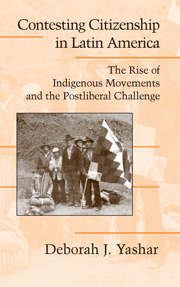 Contesting Citizenship in Latin America
Contesting Citizenship in Latin America Book contents
5 - BOLIVIA: STRONG REGIONAL MOVEMENTS
Published online by Cambridge University Press: 05 September 2012
Summary
Indigenous people constitute the majority in Bolivia. They have been treated, however, as a minority in the contemporary period. Politicians have sought to use them as pawns in a political process that has essentially granted them a subordinate position. The Bolivian National Revolution of 1952 sought to do precisely that – to incorporate peasants while denying them their indigenous identity. Contrary to elite mestizo expectations, however, indigenous peoples did not entirely assimilate into a dominant culture nor did they accept the late-twentieth-century policies that increasingly threatened their survival.
Significant regional indigenous movements emerged in the Andes and the Amazon initially to defend their local autonomy and, ultimately, to demand an equal position in the democracy that was forged in the 1980s and 1990s. These movements gained national recognition with their mobilizations as well as their initiative in policy debates. Indeed, by the end of the twentieth century, indigenous movements had organized communities throughout the country and had fundamentally changed the terms of political discourse. They had taken part in reform discussions for land reform, territorial autonomy, municipalization, educational reform, and census taking, among other issues.
This chapter explains the emergence of Bolivia's two regional indigenous movements by analyzing changes in citizenship regimes, political associational space, and organizational networks. As in Ecuador, these three variables explain the motive, opportunity, and capacity, respectively, of Bolivia's first indigenous movements.
- Type
- Chapter
- Information
- Contesting Citizenship in Latin AmericaThe Rise of Indigenous Movements and the Postliberal Challenge, pp. 152 - 223Publisher: Cambridge University PressPrint publication year: 2005


